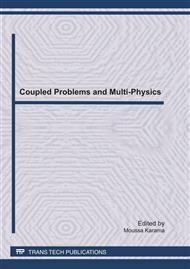p.1
p.13
p.23
p.33
p.43
p.53
p.61
p.71
Simulation of a Wall Jet Flow over a Rectangular Cavity
Abstract:
The simulation of a turbulent wall jet flow over a rectangular cavity is realised by the low Re stress-omega model. FLUENT 6.3 CFD code was used as the solver. The structured grid was built using Gambit 2.3. A preliminary study of a wall jet flow and a wall jet backward facing step interaction has been undertaken to validate the turbulence model. The numerical approach reproduces fairly the experimental results. A wall jet flow over rectangular cavities of different aspect ratios was investigated. The cavity aspect ratio effect on the flow structure evolution, particularly on the reattachment phenomenon, was examined in this paper. The results of this study show that the flow structure is very sensitive to the cavity aspect ratio. The reattachment length in the wall jet incoming flow case is very short compared to that of the boundary layer incoming flow case.
Info:
Periodical:
Pages:
1-11
Citation:
Online since:
July 2011
Price:
Сopyright:
© 2011 Trans Tech Publications Ltd. All Rights Reserved
Share:
Citation:


